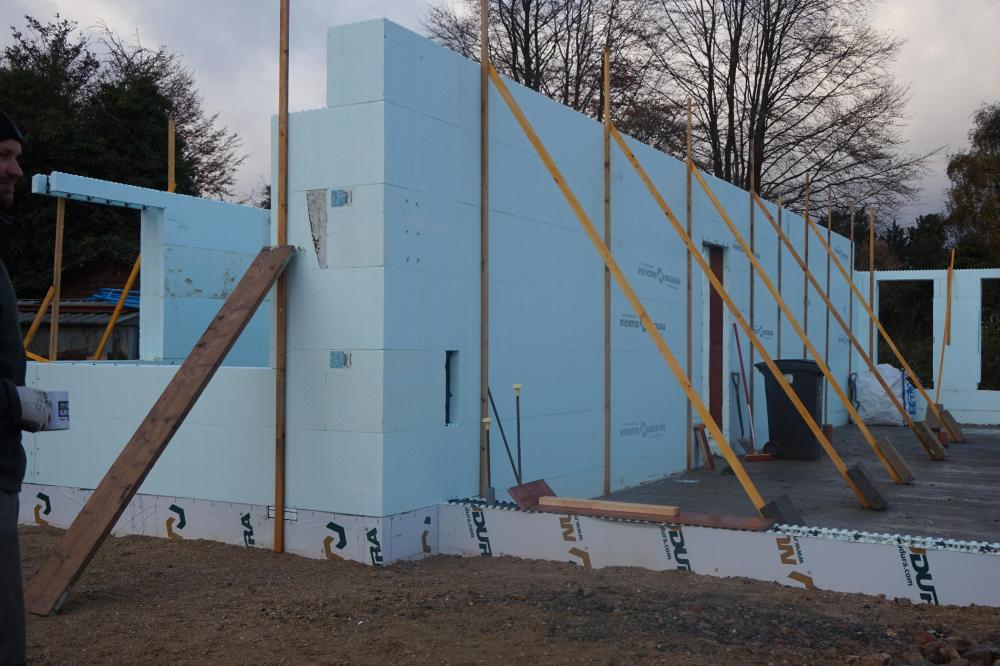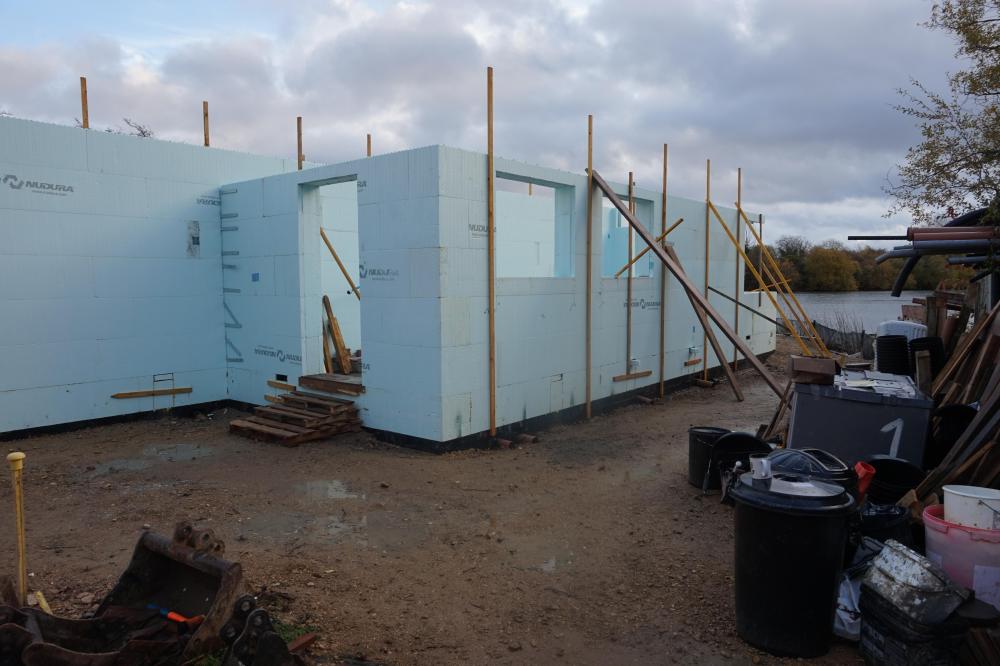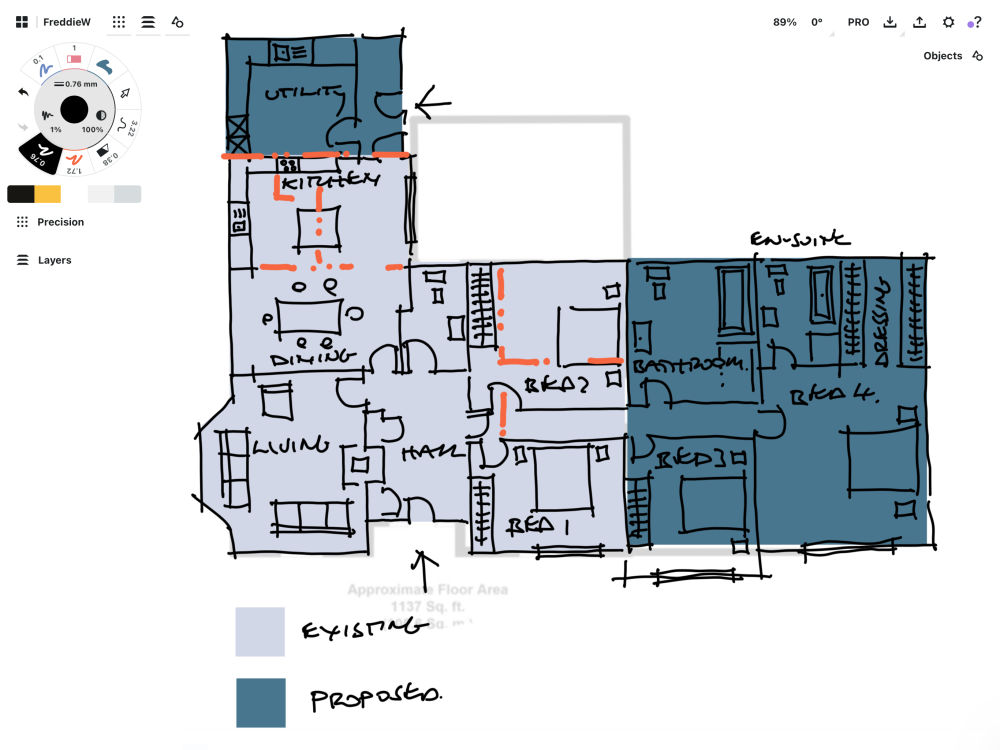Leaderboard
Popular Content
Showing content with the highest reputation on 12/23/23 in all areas
-
I didn’t get the braces on site until I had the whole structure up to 2.7m we had some bad wind and only lost a block or two. Start at the corners and leave some gaps out in the middle to let the wind through. You will need loads of scaffolding boards for when the braces come, I don’t think many bracing systems hire out with boards, so you might as well get 20 boards now and a bundle of batten and get it propped, ready for the bracing system.2 points
-
If you’re considering any flat roof extension, they may well require Full Planning as the majority do not meet the PD requirements. Don’t be limited on what can be done via PD. Your decision should be made on what you want, what can be achieved and the build costs.2 points
-
Didn't bag one of the first batch but ordered this back in October, so very happy to see it arrive just now. This will be the core of the HA system for the house alongside an array of RPi PICO Ws that will run all the remote sensors and any actuators we feel we need. Lets see if I can squeeze enough time this afternoon to get it up and running and put it through its paces.1 point
-
Brace as you go either with timber or alignment system. Broken blocks might only reveal any damage when you come to pour. Bridge between your rising walls and your ground floor. Fix down as well as laterally. Close off your cavities rather than cutting holes in corners. Building off a ladder holding a box kite is as fun as it sounds.1 point
-
1 point
-
I replaced a 3B with the 5, nice improvement. Active cooling is annoying, my official case fan is a bit annoying, may be faulty. Pico WH connects to sensors via GPIO pins, I have one connected to a CO2 sensor. Powered via usb and pushes values with MQTT to the 5 via WiFi for logging. Very pleased with the Pico, it hasn't skipped a beat yet.1 point
-
On the plus side the cuts look clean and done with a stihl saw and not just hacked off with a brick hammer !! Are they pointing the inside joints too ..?1 point
-
You want to check the installation manual on those assumptions. And especially on the device voltage. But yes assuming it is dual switched live control, you need two relay channels per blind. Be careful to never power both cores at the same time. Most are robust to it, but some dislike it immensely1 point
-
Keep the full and half blocks at the corners and put the smaller cuts on the straight runs1 point
-
Not in the middle of winter in an electric house. That’s one problem replaced with another.1 point
-
1 point
-
You are correct, if they're working on a gas appliance, they only have to be Gas Safe registered which requires ACS qualification and centres on gas safety. There are other qualifications a heating engineer can do such as low temperature heating system design etc. but they're entirely voluntary. The decent ones will go on additional training to know what they're doing and talking about, like to this place https://heatingacademynorthampton.co.uk/ But technically, the engineer should not have whacked up the flow temperature but put it back to where it was when he found it and if he had an issue, provided some recommendations - again not law but etiquette he should have learned while training In the last couple of years additional training material has been added to the curriculum,e.g. recently I was tested for OFTEC and that test now includes heat loss calculations, so it is is at least moving in the right direction, but not nearly fast enough IMHO. Most engineers don't really know how to make the systems efficient - just the other day I walked into a house built recently to fix a problem with the heating where the developer had put in 2 30kW boilers and the whole thing was permanently wired up to room stats through 5 zones all powered by separate pumps with all pumps set to no3 regardless of the size of the zone! All running at 70c flow temp. No timer at all and the stats were relay, so no modulation. I wonder who installed that system? Certainly not someone with good knowledge of energy efficiency, nor heat loss apparently. I've told the owners we can switch off and isolate one of the boilers, add modulating controls, reduce the flow temps and probably lose the huge low loss header and combine the zones to make 2 max. We'll see. But as @TonyT says, balancing and making efficient a system is well beyond an annual service.1 point
-
You have a power failure, open the door for a bit, problem solved1 point
-
I'm confused on this one. My understanding is as follows:- - A land registry map in NI likely shows you own to the middle of the road, particularly if rural. Given mid-ulster I assume that is the case. - Roads service have rights to maintain what constitutes the highway (hedge to hedge, fence to fence etc), by virtue of some ancient law. This feeds into maintaining sight lines over someone else's land ie a sight line exists and you just need visibility over it. - to get a new access for a property over land owned by someone else, for it to be long-standing and stand up to dispute should be a legal agreement for right of access. What confuses me is that the lay-by is yet to be built, but will be for access to your additional site. Therefore what is proposed above will end up being a shared access? In the country in NI this can be limiting for mortgages etc1 point
-
A shed could simply go on a 100mm slab, on dpm on hardcore. With or without reinforcement, which is to limit cracking. For an occasionally inhabited building I would be adding a downturn (footing) to the perimeter. Definitely mesh in it, maybe insulation, but there isn't much point in insulating the slab without the walls and roof too.1 point
-
It won't fall down. It's better practice though to cut down two blocks to fill the space, than to insert tiny bits. Also for small bits not to be at the corner. So the perfect corner would have whole blocks, or no smaller than half blocks. The left wall would therefore have the corner and next block exchanged. This is because of stresses at the corner. If one wall tries to move, the adjoining one should have as much linkage as possible to spread the stress. I don't know if this is written anywhere. Perhaps someone else can clarify. I may look in some old books.1 point
-
Both, Solax batteries/EPS inverter connected to solar, and a separate UPS for the network center of the house. I bought an online UPS, since there will be no switchover whatsoever which is better for the equipment (you effectively always run off battery, whether or not it's being charged is incidental) I'm not sure I completely follow. Indeed my entire house could run off grid for maybe 8 hours if I take it easy on my antique kettle collection, and once the solar batteries die I am estimating my UPS can carry the torch for minimal brains for a few more hours (obv if I only run the brains off solar I could go for days but that would mean no light/heat etc). Once the UPS runs low it sends that signal to the brains to power down peacefully. Yeah I tried to stick with KNX for the bulk of the backbone of the house (lights, sensors, actuators(shutters)) and loxone for mainly brains/interface1 point
-
1 point
-
I would contact highways and ask them to confirm in writing that the highway extends across the green land as mentioned in the attached deeds. Then write to the planners stating that you do not need planning permission to form an access onto an unclassified highway which the highways department have confirmed includes the green land. If worried about future come back apply for a Certificate of Lawfulness. On the grounds that that highway extends to your property boundary.1 point
-
Get an architect / technologist involved to help with the optimal layout. We did an extension and went ~600mm beyond PD under recommendation of architect... Slightly longer wait to get started but was worth it as the space was perfect.1 point
-
Remove the led strip seal the cut surface re fit led strip.1 point
-
Two resistors, 10p each and a relay in a box £5 to £10. No programming or anything special. Plus you need to output a resistance not input it. Taking an on off call for heat from the eDual and output a resistance to fool the ASHP into starting DHW heating.1 point
-
We had this nightmare last night. At 9pm, only 14hr before an international flight, I go to retrieve the passports from our safe only to find out that the key is not where I left it. 120 minutes of frantic searching, first for the keys, then for an emergency locksmith, available late at night on the last working day before Christmas. What a mess. He turned up c. 11pm and managed to get into the safe by drilling through the cylinder, after first unsuccessfully trying to pick it. Horrible experience. This morning my six year old admits to having “played with the keys in daddy’s drawer”. I’m so stupid. Should have set up the key code, rather than just rely on a key it turns out my daughter had access to…1 point
-
Not just any relay, you need a decent SSR or contactor rated at 240V AC and 16A load for a 3kW resistive load, and wiring these up needs some electrical knowledge, as it is quite easy to do this in a way that breaches code. I played it by the book and got my sparky to do the 240V stuff and sign it off. I used SSRs so I could drive them with 5V DC. You can get contactors that are driven by 12 and 24V DC. You don't need low voltage stuff signed off.1 point
-
1 point
-
Bit of of a strange layout would be better having the bedrooms together and living/day spaces together. Also lots of bedrooms for very limited living space. Massive hall space being used for nothing much. Lots of bedrooms (people) for one bathroom. Just looks like the wrong house, trying to be used, for way too many people. You maybe better doing a wrap around instead of two extensions, then rejigging the whole space to be a better layout. Or buy a different house1 point
-
We had cupboards above our previous utility room sink and have done so again in the new house with no issues. You can get away with it if the sink isn’t in constant use.1 point
-
Hi @FreddieW I would want a planning exemption certificate Long way from kitchen to lounge... Old bed 2 would have no windows?? 5 bedrooms and 1 bathroom? Lets hope hot curry is not on the menu.. Good luck Marvin1 point
-
That looks like a kitchen design error. There is a reason most people don't put cupboards above a sink. Even without the tap, you would get steam from a bowl of normal hat washing up water.1 point
-
1 point
-
Are you planning to build a house in your garden and need access? If so, the entrance details would have to be included in that application anyway. However, assuming you just want another entrance: you might need the Certificate of Lawfulness route. It is used when, for example, doing an extension, which you think doesn’t need planning permission but you want to be sure before you spend. If they’ve already told you you need planning, that hardly seems worth it though. Some planning depts seem less forthcoming with free advice than they used to be.1 point
-
There is - it is very contemporary and simple.1 point
-
Perhaps don't bother with UFH. Cover the slab with, say, 40mm PIR type insulation and top with 22mm chipboard plus your choice of floor finish. You will lose 60mm headroom. You can either have radiators or heated skirtings. For a heat source, you may find that oil is cheapest per kWh. If you oversize the rads and plan ahead you could swap out for a heat pump in the future. If / when you ditch the staircase, look at whether the replacement can be located to make better use of your space. It is often quite easy to cut out and trim a timber joisted floor.1 point
-
So when he turned the temperature down you got flow. It sounds to me like a problem with the temperature blending valve then. When it reaches the correct temperature it should stop drawing hot water from the boiler and instead just circulate the water in the loops until it cools down a bit, when it will then let a bit more hot in from the boiler. I would be changing the blending valve as my next step. Surprised none of them has suggested that.1 point
-
I just ran two quotes on compare the market dot com for buildings and contents insurance. With the details of our house WITHOUT an alarm, the quote is £150 a year CHEAPER than the exact same details WITH a fully approved professionally installed alarm. In other words, the insurer considers a house in our postcode with an alarm to be a riskier risk than the same house without.0 points
-
Don’t I know it, when my build was valued for the divorce NO account of its build quality and insulation was taken into account 🤯0 points

















